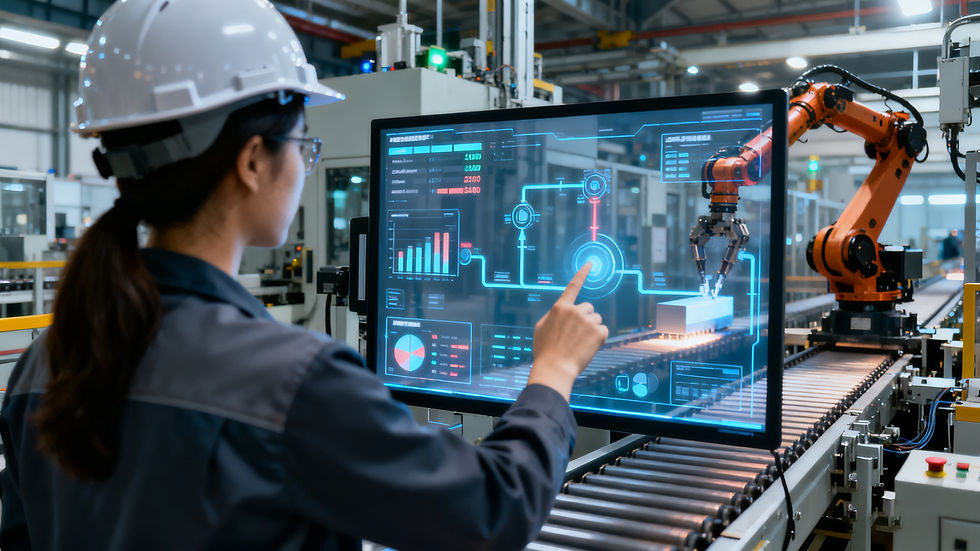Is it touch screen or touch panel?
- admin983369
- Oct 30
- 3 min read

In everyday conversation, we use "touch screen" and "touch panel" almost interchangeably. While this is often acceptable, there is a technical distinction that becomes crucial in fields like engineering, manufacturing, and product design. Understanding the difference clarifies both the function and the architecture of the device you're interacting with.
In short: All touch screens are touch panels, but not all touch panels are touch screens.
Let's break down why.
Touch Panel: The Input Device
A Touch Panel is fundamentally an input device. It is a transparent panel that is sensitive to touch, whose primary job is to detect the presence and location of a touch within its display area. Think of it as a sophisticated, see-through replacement for a mouse or a trackpad.
Key Characteristic: A touch panel is a component. It is often a separate layer that can be added to various surfaces.
Function: Its sole purpose is to relay coordinates (X, Y) of a touch to a controller, which then tells a computer what to do.
Example: The clear glass sheet on the front of your smartphone that senses your finger is the touch panel. By itself, it doesn't show anything.
Touch Screen: The Integrated Output and Input Device
A Touch Screen is an integrated output and input device. It is a complete unit that combines a display screen (the output) and a touch panel (the input) into a single, cohesive assembly.
Key Characteristic: A touch screen is a finished product or a full module. The terms "display" and "interface" are inherent to its definition.
Function: It has the dual function of showing visual information (like a monitor) and accepting touch input.
Example: Your smartphone as you experience it is a touch screen. You see the icons (output from the display) and you touch them (input received by the touch panel).
The Car Analogy
A perfect analogy is the relationship between a steering wheel and a car.
Touch Panel = Steering Wheel: The steering wheel is a component. It's an input device that you use to control the direction of the car. You could theoretically use the same steering wheel in a different vehicle.
Touch Screen = The Entire Car: The car is a complete system. It integrates the steering wheel (input) with the engine, wheels, and seats to provide the full experience of transportation.
You wouldn't say, "I drove my steering wheel to work." Similarly, in a technical context, you wouldn't call just the transparent sensor layer a "touch screen."
Context is Key: When to Use Which Term
1. Use "Touch Screen" when:
Referring to a complete consumer product or a self-contained unit (e.g., a smartphone, an ATM, a tablet).
Emphasizing the user experience of interacting directly with what is displayed.
The context is general and non-technical. For most everyday purposes, "touch screen" is perfectly correct and widely understood.
Example: "The new kiosk features a bright, 20-inch touch screen for easy ordering."
2. Use "Touch Panel" when:
Discussing the component itself, separate from the display.
Talking about the technology or the type of sensor (e.g., "a capacitive touch panel").
Referring to a touch-sensitive surface that is not a display, such as a touchpad on a laptop.
Working in design, manufacturing, or procurement, where precision is required.
Example: "We need to source a 10.1-inch touch panel that will be laminated onto our custom LCD." Or, "The laptop's touch panel (trackpad) is very responsive."
Why the Confusion Exists
The confusion is natural because the two are physically fused in most devices we encounter. The integration is so seamless that from a user's perspective, the input and output are one and the same. The industry has also adopted "touch screen" as a catch-all term for marketing and simplicity.
Conclusion:
While you can often use the terms without causing misunderstanding, knowing the difference adds precision:
If you're talking about the entire interactive display, you're referring to the Touch Screen.
If you're talking about the transparent sensor that enables the touch functionality, you're referring to the Touch Panel.
So, the next time you tap an icon on your phone, you'll know you're using a touch screen made possible by an underlying touch panel.


